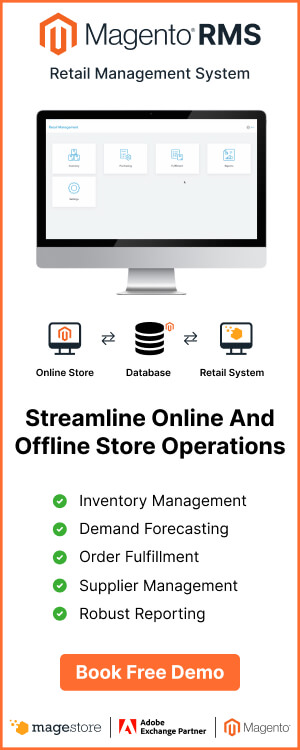More and more merchants are choosing the Magento platform to run their businesses because of its features, scalability, and flexibility. Magento is normally used by enterprises as their online sales channel and integrated into ERP and accounting systems. Small and medium businesses prefer Magento as a centralized system that covers sales, fulfillment, inventory, procurement, and more.
No matter the size of your company, if you’re just starting a Magento website, you probably have no idea where to begin and how to do it.
Below, we’ll guide you to build a Magento site from scratch based on real insights from working with global retailers.
Checklist to complete before you start
You should prepare some key aspects of starting an online store, as well as a plan that is tailored to your online store before you jump into installing Magento. The following items will help you establish a strong foundation to take full advantage of Magento. You may skip ahead to the next part if you have already done them.

Prepare your brand guidelines
A brand guideline including logos, color palettes, and typography enables you to present a consistent image on your Magento website as well as speed up the pre-production of content.
Understand taxes that relate to your business
Each European country has a different VAT rate. In order to avoid penalties, businesses operating in multiple jurisdictions must ensure that the correct VAT rates are charged.
For example, VAT rates of EU members are different across countries. Hungary’s VAT rate in 2021 is 27 percent and Germany’s is 19 percent. You should make sure that you’re aware of the tax rate and set it up in your system to comply with the tax law.
Define shipping, payment methods, and loyalty programs you want to offer to your customers
It’s essential that you have a clear plan about what you want to offer your shoppers. Ask yourself the following questions:
- How many shipping options are there for customers and what are they? (Ex: In-store pickup, free shipping, DHL, etc)
- What are the payment methods available to customers? (Ex: Paypal, Authorize.net, COD, etc)
- What promotions will you run to promote your business? (Ex: Buy 1 get 1 free, special price, etc.)
Answering the above will help you prepare the materials that will make things easier for the people who will set up your Magento store.
Have requirements with priority for your online store
You should come up with a list of system requirements that include why you need those features and how you expect them to work. After that, you prioritize the requirements and check whether you can implement all of them with Magento core only or if you need extensions or additional customization. Finally, remember to implement the must-have features before the launch.
How to launch a new Magento store: 10 phases involved in the process
Once you prepare the branding guidelines, tax policy, loyalty program, and other details, it becomes easier to set up your Magento eCommerce store, because you know exactly what needs to be done.
During the launch of your site, you’ll go through 10 phases. Depending on your resources, you may want to break the phases up or take on many phases at once.
- Get your infrastructure in place
- Make sure you have your master data set up
- Enable complete checkout process
- Design and set up standard pages
- Provide about us, contact us, FAQ, and terms and policy pages on your website
- Implement search engine optimization (SEO)
- Set up analytics
- Install other extensions and plugins
- Training your staff
- Go live the system

Phase 1. Get your infrastructure in place
Your technical team needs to register cloud computing platforms such as Amazon Web Services and Cloudways and configure hosting.
In addition, it’s essential to prepare all deployment environments, such as the development, staging, and live environments. The purpose is to ensure that the software development process doesn’t affect your business operation.
Lastly, you can install Magento and test its functionality. When the installation is successful, you will be able to move on to the next phase, which is creating the master data.
Phase 2. Make sure you have your master data set up
An eCommerce company has a large amount of master data. These data are centralized, updated, and shared in the right format across all systems and people who need them.
There are various types of master data that you’ll manage in an online business.
- Product data
- Category master data
- Customer data
- Customer group
This phase involves preparing master data CSV files and importing them into Magento. A critical task in this phase is to make sure that your database has fresh, accurate, and no duplicate information. The more data you have, the more effort you have to put into preparing it.
Tips: Magento merchants moving from another eCommerce platform to Magento can use a migration tool instead to transfer data.

Phase 3. Enable complete checkout process
During checkout, your customers will typically go to the shopping cart, enter billing information, shipping information, choose the shipping method, choose the payment method, and confirm the order.
You need to set up offers from the Magento backend and ensure that the frontend displays the information and the customer can check out smoothly. Here are the components you can configure.
- Tax rates and tax rules
- Promotion rules
- Payment methods
- Shipping methods
- Language
- Currency
Phase 4. Design and set up standard pages
According to Research Gate, 94% of first impressions are related to design. Every online store needs an eye-catching design that will draw customer attention and keep them staying on your website longer. For that reason, businesses are trying to make their websites as easy to use and attractive as possible.

At this point, we recommend investing in a website design that is tailored to your business industry and brand. Below are some standard pages you need to complete before your launch.
- Homepage
- Product list page
- Product page — Grid view/List view
- Categories page
- Product detail page with images, key features, and other info
- Shopping cart
- Payment page
- Successful checkout page
- Customer account page
- Order status tracking
Tips: A good way to come up with website UI/UX ideas is to refer to other brands and competitors in your industry. Additionally, you can choose a Magento theme from a large selection of free and paid themes on the Magento marketplace or build a Magento storefront.
Phase 5. Provide about us, contact us, FAQ, and terms and policy pages on your website
During the buying journey, customers care not only about what they want to buy, but also who supplies the product, what the return policy is, and how to contact you in case of an emergency. This information should be clear on your website to win your customers’ trust and reduce the time to answer customers’ questions.
Phase 6. Implement search engine optimization (SEO)
In the modern digital world, SEO is no longer an option, it has become a necessity. It’ll be hard for you to become a part of the eCommerce game if you do not implement SEO. Let’s see key suggestions you should follow to help your site get closer to your customers.

Add page title and meta description
Page titles and meta descriptions are what show up in search results. The title and meta description of every page should be unique and descriptive so that search engines can identify whether the page fits a search query or not.
Create a sitemap.xml
The site map contains information about the web pages, videos, and other files on your site, and the relationship between them. Google, for example, uses this file to intelligently crawl your site and provide useful information about users’ search query.
Create a robots.txt file
This file tells search engine crawlers which pages or files they are allowed to or not allowed to crawl from your site. The robot.txt file contains the proper instructions to prevent search engine bots from crawling unimportant URLs on your site, thereby saving your site’s resources for important pages, as well as saving your crawl budget.
Phase 7. Set up analytics
Analytics provide insights into the behaviors of your visitors and how you can improve your site. Moreover, it’s a good way to measure the effectiveness of SEO and marketing campaigns.
Integrate Google Analytics with your website
With Google Analytics, you can obtain a wealth of detailed information about the visitors to your site. Using this tool, you can track traffic to your website, where your visitors come from, demographic information, and more.
Setup and configure Google Tag Manager(GTM)
Using GTM, your website can be updated with measurement codes and related code fragments collectively referred to as tags. By this way, you can track customer behaviors like submitting a form or viewing a video.

Advanced Google Analytics eCommerce tracking
Measuring user journeys through the sales funnel will help you identify the points where money is being lost from the website. You can use Google Tag Manager (GTM) to set up eCommerce events and send them to Google Analytics. ECommerce websites can measure the following events.
- Product list impressions
- Click on products
- View product details
- Add or remove products from a shopping cart
- Initiate the checkout process
Phase 8. Install other extensions and plugins
Magento core may not meet all of your business’s requirements. Adding more extensions and plugins is necessary in this situation.
Your Magento websites may need several features that make sales easier, such as store locator, store credit, store pickup, etc.

Some merchants even want to integrate Magento with offline channels, Facebook, or the marketplace.
You should ensure all necessary extensions work well on your site before your grand opening. Nice-to-have requirements can be added later.
Phase 9. Training your staff

In this phase, you’ll need to train your staff on how to use the system. It’s never easy to learn Magento when it’s the first time your staff work with this platform or are not tech-savvy.
You can also hold a demo meeting to educate them about the new system and get feedback. In case you work with a Magento service provider, don’t forget to ask them for training.
Phase 10. Go live the system
It is finally time to launch the website and start using the system to record the very first sales orders. Don’t expect that everything will be perfect. There may be unexpected issues such as human error or bugs. You might even feel embarrassed when you are unfamiliar with the new system and don’t know how to solve certain situations. You should try to keep calm, find workaround solutions, and spend the next days fixing the issues.

Tips: Make sure to notify your Magento solution provider when you’re planning to go live, so you can receive 24/7 support at least 2 weeks before and after your go-live event.
The best practices after your launch
According to Wpforms, there are an estimated 12–24 million eCommerce sites across the entire globe, with more and more being created every single day. It’s quite competitive for eCommerce retailers to make their website stand out to attract customers every day. Therefore, launching a website is just the start, and you’ll need to achieve much more later.

If you still wonder what you should do, you can start with one of the following best practices.
- Implement nice-to-have features that you have planned but not done before going live
- Get feedback from customers to improve your site
- Run Google Analytics reports to get insights and optimize your conversion rate
- Check your site speed regularly
- Optimize your site for mobile users
- Build an email subscriber list from your site and run email campaigns
- Feature your customer reviews on your website
- Provide multiple ways to get in touch with you such as live chat, social media profile, etc.
In a nutshell
Congrats! You’ve gone through all the necessary phases to launch a Magento store. The time that it takes for an eCommerce site to go live will depend on your business size and how tech-savvy you are.
To get your site online quickly, we recommend you partner with a Magento service provider who will work with you to build a roadmap and help you implement it.
Happy selling!
Related articles













